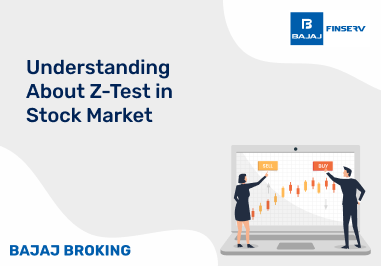BAJAJ BROKING
Indo Farm Equipment IPO is Open!
Open a Free Demat Account
Trade Now, Pay Later with up to 4x
Track Market Movers Instantly
Today’s Market Crash Explained: What’s Dragging Down Sensex and Nifty?
Investors in India woke up to a rough start this Monday as both Sensex and Nifty 50 plunged by over 1.7%, wiping out more than ₹5.5 lakh crore in market value. But this isn’t just a blip on the radar—multiple factors are driving the market’s downward momentum. Let’s take a closer look at what’s going on under the surface and why Indian markets are feeling the heat.
1. Global Uncertainty – All Eyes on the U.S.
Indian markets don’t operate in a bubble. Right now, global factors are creating ripples that are hard to ignore. One major factor is the U.S. presidential election. This week, investors are glued to news from the U.S. since the outcome will likely shape global trade policies, regulations, and economic forecasts. A Democratic win might encourage new policies on climate and social spending, while a Republican win could shift focus to business-friendly deregulations. With so much at stake, Indian investors are cautious, knowing that global economic shifts tend to impact emerging markets like India.
Adding to the pressure is the upcoming U.S. Federal Reserve meeting. Speculation is rife about another potential interest rate cut, which could pull foreign investments towards U.S. markets in search of better returns. Until there’s clarity on this front, it seems FIIs (Foreign Institutional Investors) are treading carefully, which is contributing to market volatility in India
2. Rising Interest Rates and FII Pullback
Interest rates are a major player in the current situation. The RBI has been cautious with rate cuts amid high inflation, and this conservative stance is impacting FII sentiment. Foreign investors, always on the lookout for attractive returns, seem hesitant to make fresh investments in India while domestic rates remain relatively high and the U.S. rates might see changes soon.
The pullback by FIIs has a noticeable impact, especially in sectors with high exposure, like banking and IT. In fact, recent data shows that FIIs have been net sellers, which applies more downward pressure on stock prices in these key sectors.
3. Banking, Financials, and IT Stocks Under Pressure
The market has seen the biggest drops in banking, financial, and IT stocks. The banking and financial sectors, in particular, are struggling with higher provisions for bad debts and a cautious lending outlook, which are putting pressure on profits. Uncertainty around interest rates and reduced foreign inflows only add to the burden, resulting in a slump in stock prices.
The IT sector isn’t faring much better. With companies like Infosys and TCS heavily dependent on Western clients, budget cuts among major clients in the U.S. and Europe are hitting revenues. The sector is also grappling with the potential of rising U.S. rates, which makes Indian IT stocks less attractive to international investors looking for secure, stable returns.
4. Disappointing Q2 Earnings and Expensive Valuations
The Q2 earnings season has been less than encouraging. Sectors such as pharma, auto, and manufacturing have reported mixed results, often citing rising costs, weak demand, and supply chain disruptions. These headwinds are weighing on overall profitability, and with high valuations, there’s not much room for error.
Right now, Nifty’s P/E ratio is around 24 times FY25 earnings estimates, which means valuations are high and hard to justify without strong earnings growth.
5. Volatility Index (VIX) and Investor Caution
India’s Volatility Index, or India VIX, saw a sharp spike, signalling a wave of investor caution. Known as the “fear gauge,” a rising VIX typically means investors expect price swings and are feeling wary about the near-term market direction. This spike reflects the cautious mood across the market.
6. Rising Oil Prices and Global Macroeconomic Tensions
Oil prices are on the rise globally, adding inflationary pressure to several sectors. India, a significant oil importer, is especially sensitive to these fluctuations. Higher crude prices translate to increased input costs for industries ranging from transportation to FMCG, and can lead to reduced consumer spending as everyday goods become more expensive. Rising oil prices also affect corporate margins and ultimately stock valuations.
Geopolitical tensions are adding another layer of complexity. With commodity prices in flux, companies dependent on raw materials are facing higher costs, and this financial squeeze is showing up in stock performance, especially in sectors like metals, pharma, and FMCG.
What Should Investors Do?
While a drop of over 1% is concerning, market corrections are part of the financial cycle. Investors with a long-term view know that periods of volatility can reveal buying opportunities, especially in sectors that show solid fundamentals.
For now, caution is the name of the game. Until we see more stability in global factors like the U.S. election and interest rates, short-term volatility may persist. But staying informed and focusing on sectors with strong growth potential can help investors navigate this challenging period and find value in what might look like a sea of red.
In Summary
Today’s market slump reflects a web of interconnected factors: global uncertainties, interest rate policies, disappointing earnings, sector-specific pressures, and rising commodity prices. While it’s easy to get spooked by headlines, taking a step back and understanding the bigger picture can help investors make level-headed decisions. With so many forces at play, the Indian market is indeed going through a recalibration, but this doesn’t necessarily signal a prolonged downturn. Stay informed, stay calm, and keep an eye out for opportunities amidst the chaos.
Disclaimer: Investments in the securities market are subject to market risk, read all related documents carefully before investing.
This content is for educational purposes only. Securities quoted are exemplary and not recommendatory.
For All Disclaimers Click Here: https://bit.ly/3Tcsfuc
Share this article:
- Related Articles
- Top Articles

Gold Rate Today | 2 January 2025 | Gold Price in India
02 Jan, 2025 | 40 Min. read

Lloyds Metals Reports Record Iron Ore Output, Stock Hits 52-Week High
02 Jan, 2025 | 2 Min. read

Commercial Property Insurance Premiums Surge by 80% from January 2025
02 Jan, 2025 | 2 Min. read

Cabinet Increases PMFBY Allocation to ₹69,515 Crore for 2025-26
02 Jan, 2025 | 2 Min. read

How to Apply for Fabtech Technologies Cleanrooms IPO?
02 Jan, 2025 | 1 Min. read

Fabtech Technologies Cleanrooms IPO
02 Jan, 2025 | 3 Min. read

HDFC Life Faces ₹270.58 Crore GST Demand, Plans to Appeal
02 Jan, 2025 | 2 Min. read

T-Test: Definition, Types, How To Use and Examples
02 Jan, 2025 | 4 Min. read

Z-Test: Definition, Uses in Statistics, and Example
02 Jan, 2025 | 4 Min. read

Piramal Enterprises Invests ₹1,000 Crore in Piramal Capital via Rights Issue
01 Jan, 2025 | 2 Min. read

Kalpataru Projects Secures ₹1,011-Crore Orders Across Key Sectors
01 Jan, 2025 | 2 Min. read

Transformer & Rectifier to Consider Bonus Issue on 8 January
01 Jan, 2025 | 2 Min. read

RBI Launches ULI: Transforming Loan Access
August 27, 2024 | 4 Min. read

Textile Sector in India
September 20, 2024 | 5 Min. read

List of IPOs with DRHPs Filed
November 30, 2023 | 3 Min. read

Aditya Birla Group
September 28, 2023 | 10 Min. read

Bajaj Housing Finance Ltd IPO: Things Smart Investors Need to Know
September 05, 2024 | 4 Min. read

Budget Stock Ideas 2024-2025 | Stocks to Buy Today
July 24, 2024 | 4 Min. read

IPO Eligibility Criteria : Full Details
March 15, 2024 | 6 Min. read

What Is the Lock-In Period in IPOs?
October 18, 2023 | 6 Min. read

Godfrey Phillips Announces 2:1 Bonus Shares
September 16, 2024 | 7 Min. read

Jindal Group- A Comprehensive Analysis
September 27, 2024 | 7 Min. read
Read More Blogs
Our Secure Trading Platforms
Level up your stock market experience: Download the Bajaj Broking App for effortless investing and trading



